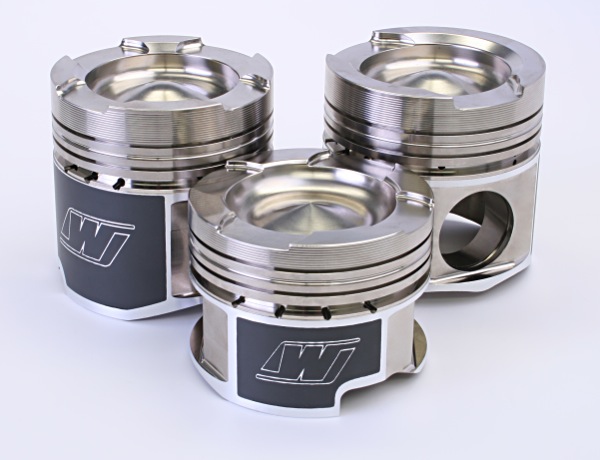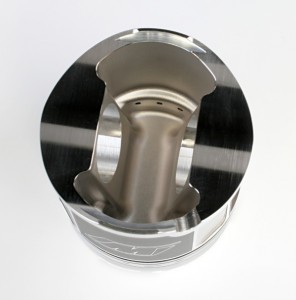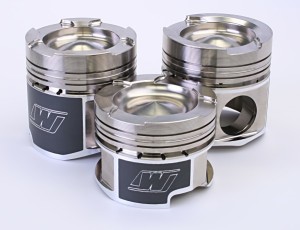
The pistons are some of the hardest working components inside a diesel engine.
Diesel engines are high compression, high heat engines that demand a lot from their pistons. Compression ratios are typically in the 16:1 to 20:1 range, which improves thermal efficiency and fuel economy, but also creates more pressure.
Cylinder pressures in many production diesel engines may range from 2200 up to 2700 PSI or higher depending on the engine’s power rating, compared to 1450 PSI for a naturally aspirated gasoline engine or 2100 PSI for a turbocharged gas engine.
Diesel pistons also have to contend with more heat than their gasoline counterparts. Flame temperatures can range from 2600 degrees F to over 3600 degrees F in the piston’s combustion bowl, producing surface temperatures of up to 750 degrees F or higher in the rim area around the bowl.
At such temperatures, aluminum pistons can be dangerously close to their melting point, so oil cooling is essential to dissipate heat, cool the rings and control thermal expansion.
Keeping ‘em Cool…
Diesel pistons are cooled by spraying oil at the underside of the piston and directing some of the oil into hollow cavities or galleries in the top portion of the piston behind the upper ring land.
On some pistons, an oil cooling duct is created in the back of the top ring insert by welding on a steel plate. Oil cooling lowers the temperature of the top ring up to 100 degrees F or more for better sealing, less blowby and longer piston and ring life.
…And Give ’em Room
High operating temperatures also mean diesel pistons usually need more clearance to accommodate thermal expansion – especially when an engine is being modified to produce more power. On a stock Duramax, the factory recommends about .002 inch of piston-to-wall clearance.
For a street performance/drag application, you might want to allow .006 to .008 inch of piston clearance depending on the type of pistons used (cast or forged) and the amount of boost pressure.
For a high boost diesel engine being used in a pulling application, you might need as much as .012 to .013 inch of clearance.
Diesel Piston Material
Most production diesel pistons are still cast aluminum, though new materials are coming into use (more on this in a minute).
One would think diesel pistons would be forged aluminum to handle the higher loads and heat, and some aftermarket performance pistons for diesel engines are 2618 forged aluminum or even CNC-machined billet aluminum.
However, cast aluminum pistons have long been used for most production diesel engines because cast pistons can be easily molded with a steel upper ring land to extend the durability of the rings. Castings are also less expensive than forgings or other materials.
The pistons that are used in light truck diesel engines such as GM Duramax, Ford Powerstroke and Dodge Cummins tend to be longer and heavier than the pistons used in gasoline engines.
Bore sizes in these engines can range from 3.74 inches up to 4.21 inches depending on the application, but piston weights can be as much as 1000 to 1200 grams with a 300 to 400 gram wrist pin.
The extra weight doesn’t matter much because a stock diesel engine typically operates at relatively low RPM (under 4,500 RPM). But if you’re modifying one of these engines for pulling or drag racing, you’ll likely want a lighter forged piston that can handle higher engine speeds. You’ll also need different pistons if you’re building a stroker motor.
One piston supplier we interviewed for this article said the original equipment stock pistons in Cummins engines are “over built” for durability. The wrist pins are large and heavy so they will last a long time, which is great for a hard-working daily driver.
But for a diesel performance engine, you may not need so much beef. The pins can be lightened up by using pistons that have smaller and shorter wrist pins.
Durability should not be an issue with smaller, lighter wrist pins because a diesel engine used for pulling or drag racing only experiences maximum load for a relatively short period of time. It isn’t expected to go 200,000 miles or more like a production engine.
Lighter performance pistons can also make engine balancing easier and less expensive in certain applications.
With Duramax engines, the crankshaft should be internally balanced for performance use rather than externally balanced.
But this can require a lot of heavy metal in the counterweights. Using lighter pistons can minimize the amount of heavy metal that’s needed to achieve an internal balance.
One piston manufacturer said the trend towards lighter diesel performance pistons is only going to accelerate. The manufacturer expressed that the pistons they will be making a few years from now will be much different and lighter than the ones they are producing for performance diesel engines today.
Diesel Piston Coatings
Many aftermarket suppliers of forged pistons for diesel engines use various types of coatings and surface treatments on their pistons. Anodizing and similar treatments are typically used in the ring grooves and crown area for durability. Many consider anodizing a must if you’re building a high boost engine for the pistons and rings to survive.
Anti-friction coatings are also popular on the piston skirt to provide scuff protection.
These “dry film lubricants” may contain such ingredients as molybdenum disulfide, tungsten disulfide and/or PTFE (Teflon) in a thermosetting polymer binder (water or solvent based).
Dry film coatings are typically formulated to provide surface lubricity and protect against friction, galling and wear. A dry film coating provides an extra margin of safety if oil pressure is lost (at least for awhile), and helps prevent metal-to-metal contact under extreme pressure or following a dry start.
Dry film lubricant coatings on piston skirts typically add about .001″ to the piston diameter, so the question often comes up as to how this affects piston installation clearances.
One piston manufacturer said it is not necessary to compensate for the coating when figuring piston-to-bore clearances. “Just pretend the coating isn’t there,” is their advice. Use the piston size on the box to calculate clearances, not the actual diameter of the coated piston.
Another type of coating that may be used on diesel pistons to enhance performance and heat management is a ceramic-metallic coating on the top of the piston and in the bowl.
In theory, heat reflecting coatings improve thermal efficiency and help pistons run cooler.
But if the surface isn’t prepared properly before the coating is applied, it may flake loose under heat and load.
Piston Bowl Configurations
Some aftermarket performance pistons are reworked stock cast pistons. “De-lipping” the bowl area to open up the combustion chamber is a common modification.
A more open bowl allows longer injector duration for more power. The size, shape and angle of the center cone (if used) in the bottom of the bowl may also be modified to match the spray pattern of a particular set of injectors.
One thing you do have to keep in mind when replacing pistons in an unmodified diesel engine is to make sure the replacement pistons have the same bowl configuration as the original. This is important to maintain the same compression ratio and combustion characteristics that were designed into the engine so you don’t adversely affect fuel economy, performance or emissions.
For example, on Cummins diesels there are more than 25 different pistons for Cummins B-series engines which include variants for on-road, off-road, marine, turbocharged and non-turbocharged, different ring packs, etc.
To get the right replacement piston, you need to know the “CPL” (Critical Parts List) for the engine application. The CPL lists all of the major parts that are used in the engine, including the pistons, cam, injectors and turbo. You may also need the original equipment serial number on the piston, which may be etched or laser printed on the top of the piston. There may also be a raw casting number inside the piston, but this is not application specific because the same casting may be machined different ways for different engine applications.
Steel Pistons
Big over-the-road heavy-duty truck engines are expected to last a lot of miles, upwards of a million or more with proper maintenance and care.
Cast aluminum pistons hold up well enough in light to moderate use applications, but for high output engines, two-piece “articulated” pistons with steel crowns and aluminum skirts may be used for improved durability.
The wrist pin holds the two pieces together, and allows the piston to handle higher loads than would be possible with a one-piece cast piston.
One-piece steel pistons have also been around for a number of years and offer numerous advantages over cast aluminum, forged aluminum and two-piece aluminum/steel pistons in hard working diesel engines.
Steel pistons are more expensive to manufacture than cast or forged aluminum pistons, but steel is much stronger than aluminum and can handle higher loads and temperatures without failing.
Weight would seem to be a disadvantage, since steel is a heavier and denser metal than aluminum.
Yet steel pistons can be as light or even lighter than aluminum pistons, if mass is removed in areas where extra strength isn’t needed. Ring land wear is also not a problem with steel pistons because the entire piston is steel.
Another advantage with steel is that its coefficient of thermal expansion is similar to that of a cast iron engine block.
Aluminum expands at a much higher rate than steel as it heats up, which increases the risk of piston scuffing and wiping out a cylinder if the engine gets too hot.
Cylinder Sleeves And Liners
Light duty diesel engines are like most gasoline engines, in that they have cast iron blocks with either aluminum or cast iron heads.
If one or more cylinders are worn or damaged, they can often be salvaged and restored to their original bore diameter by boring the block and pressing in a dry sleeve.
According to the people who make sleeves, centrifugal spun-cast ductile iron sleeves should be your first choice for any type of performance application.
Ductile iron has more tensile strength than ordinary gray iron, as well as more “give” (elongation) which allows it to resist cracking under higher loads.
There are also different grades of ductile iron, some of which are significantly better than others. Sleeves and liners that are spun cast also provide a more uniform and consistent metallurgy, so the sleeves don’t have hard spots or inclusions that may cause problems later on.
Sleeves are usually semi-finished, and are not final finished until after the block has been bored and the sleeve has been pressed into position in the block. Wet liners, by comparison, are often finished to specifications and are ready to install.
Dry sleeves require a certain amount of press fit to hold the sleeve in place.
The recommended amount of interference will vary depending on the type of metal the sleeve is made from, the type of engine block and the application.
With similar metals (iron sleeve in an iron block), the standard press fit recommendation is usually .001 to .002 inch of interference.
With dissimilar metals (iron sleeve in an aluminum block), as much as .003 inch of interference may be recommended.
One tip that makes dry sleeve installation easier and also improves cylinder cooling is to lightly brush the cylinder bore after it has been bored to accept the sleeve. This will smooth the surface of the bore allowing the sleeve to slide into place more easily. A smoother surface will also allow better metal-to-metal contact between the sleeve and block for good heat transfer.
Steel sleeves are used in some puller motors and other diesel racing applications for their hardness and strength. But steel is harder on rings than ductile iron, so don’t expect the rings to last forever if you end up installing steel sleeves in a motor you are building. Plain cast iron rings often work best with steel sleeves.
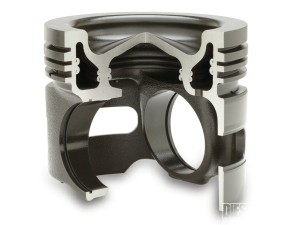
The wet liners that are used in heavy-duty diesel engines are essentially drop-in cylinders that are sealed at the top and bottom with a flange and o-rings.
The amount of slip fit will vary depending on the application, so follow the OEM recommendations. Wet liners are thicker than repair sleeves or cast-in-place sleeves because they have no metal around them to provide added support. As with dry sleeves, ductile iron liners provide the extra strength needed for high output applications.
Wet liners can fail from fatigue cracking, or as a result of cavitation erosion.
Every time the cylinder fires, it expands and contracts slightly causing small bubbles to form in the coolant that is circulating around the outside of the liners. When the bubbles implode, they do so with great force and chip away at the outside of the liners.
Over time, cavitation can pit and erode away so much metal that the liner eventually perforates and allows coolant to leak into the cylinder. This can cause the engine to overheat, or it can even hydrolock the cylinder.
Cavitation erosion is often the result of coolant neglect, or using a coolant that does not contain “Supplemental Coolant Additives.” These additives include nitrite and/or molybdate that form a protective oxide film on the outside of the liners that helps them resist cavitation erosion.
Fully formulated heavy-duty engine coolants that meet ASTM D6210 or similar standards contain the proper additives to resist cavitation erosion.
Piston and Sleeve Finishing and Break-In Tips
When finishing diesel cylinder bores or sleeves, a two or three step process that results in a plateau finish is usually best to reduce ring break-in and seating time. The type of honing stones, feed and pressure used to finish the cylinders will vary depending on what kind of finish you want to achieve.
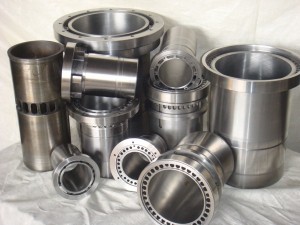 As a rule, you should avoid trying to remove too much metal too quickly, using too much feed pressure and excessive dwell time to minimize heat build up that can distort the bores.
As a rule, you should avoid trying to remove too much metal too quickly, using too much feed pressure and excessive dwell time to minimize heat build up that can distort the bores.
Using torque plates is always recommended to improve bore geometry.
After the cylinders have been finished to specs, they must be scrubbed clean with hot soapy water and a brush to remove all traces of honing residue. Once the cylinders are clean, they can be lightly oiled with break-in oil.
Use a conventional oil or a break-in oil for the initial start-up and break-in process, not a synthetic oil. Prime or pressurize the oil system prior to starting the engine. Once it starts, rev it up to 2000 to 2500 RPM for 30 minutes while varying engine speed as the rings seat.
Once the break-in process has been completed, drain the oil, change the filter and refill the crankcase with whatever oil will be used from that point on (conventional 15W-40 or synthetic 15W-40 or 5W-40 typically).

